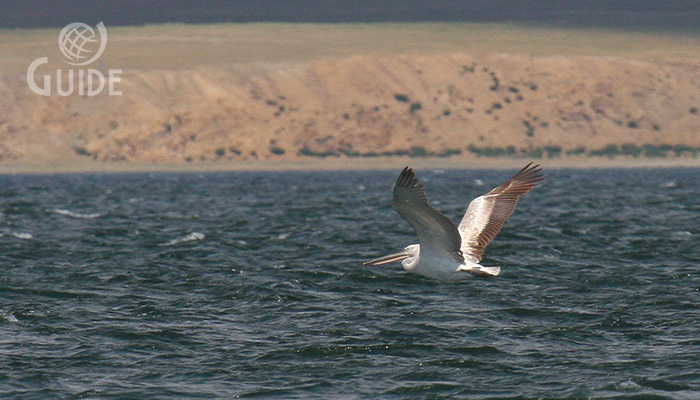
English: Dalmatian Pelican
Russian: Кудрявый пеликан
German: Krauskopfpelikan
French: Pelican frise
Mongolian: Борцгор хотон
Japanese: ハイイロペリカン (Haiiro-perikan)
Body
length: 160-180 cm
Wing
span: 270-320 cm
Status: Very rare species. According to the
International Union for Conservation of Nature (IUCN) Red List Threatened
Species categories and criteria, the species evaluated as Critically
Endangered.
Distribution and Range: Distribution is limited from the Yellow river west to the Balkan
Peninsula, from the Persian Gulf to Khar Lake in the Kustanai Region. Winters
in Iraq, Persian Gulf, Egypt, India and south east China. In Mongolia: Khar Us
Lake is the species nesting habitat. Migrating birds can be seen in open steppe
in saline lakes, i.e., the Valley of the Lakes, the Zavkhan River and the Great
Lakes Depression; non-breeding adults and immature birds have been recorded on
the Uvs, Khyargas, Bayan and Ogii Lakes.
Habitat: It breeds by large stretches of water, in drier raised areas in
reed beds. Nests in the catchment areas of rivers and lakes that have abundant
fish and vegetation. By October the bird family leaves the breeding site for
wintering grounds.
Population and threats: There are 3200-4300 Dalmatian Pelicans throughout the world. In
the summer of 1956 over 300 were recorded on Shuvuun Tsuglaan, Khar US Lake;
only 207 were counted in 1972 and 13 in 1981. In 1976, 10 were counted on
Kyrgas and 13 on Oigon Lake. In the autumn of 1979, 50 were counted on Kholbooj
Lake, Bayankhongor. One was recorded on Uvs Lake in 1985. The latest
unpublished data indicates that there are now about 200 Pelicans in Mongolia.
However, since 2000 population has been declining drastically, from 2005
Pelicans started coming back in small numbers to its breeding and nesting
habitat. In June 2010, 120-150 birds were recorded on the Tsagaan River islands
of the Khar Us Lake. High fluctuations in the Lake water level, degradation of
the breeding sites, i.e., the island and lake shorelines’ reduce nesting
success, leading to destruction of eggs, with Nests for abandoned for long
periods of time, when disturbed, leaving the eggs and young fledgelings open to
predators such as gulls and foxes. Local tradition of using pelican beaks to
make horse sweat scrapers, maybe dwindling the pelican population, might bring
it to its extinction.
Conservation Measures: Hunting of this species was prohibited since 1953. Listed as very
rare animal in the Mongolian Law on Fauna, included in the Convention on
International Trade in Endangered Species (CITES) Annex I, Convention on
migratory Species (CMS) Annex I and II in the Convention on Wetlands of
International Importance, especially as Waterfowl Habitat (RAMSAR), Khar Us
Lake, Orog Lake, Buir Lake, and their surrounding wetlands are RAMSAR sites,
included also in the Mongolian Red Book (1987, 1997). Distribution area is
partially included within the Uvs Lake Basin Strictly Protected Area, and the
Khar Us Lake National Park.
Further Action: Main habitat area, nesting habitat protection especially during
breeding season, intensify enforcement and monitoring efforts; prohibit future
manufacturing of horse sweat scraper from pelican beaks, employ cooperative conservation
methods of natural resource management within distribution area and involve local
participation in conservation efforts, put a stop to poaching, organize works
in reducing and stopping degradation of the Lakes shorelines, and raise
awareness.